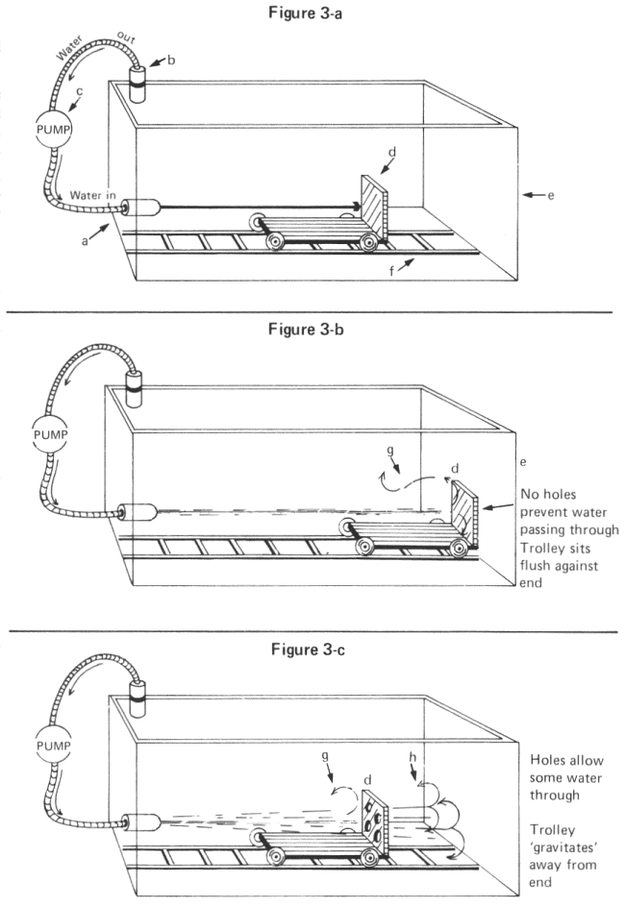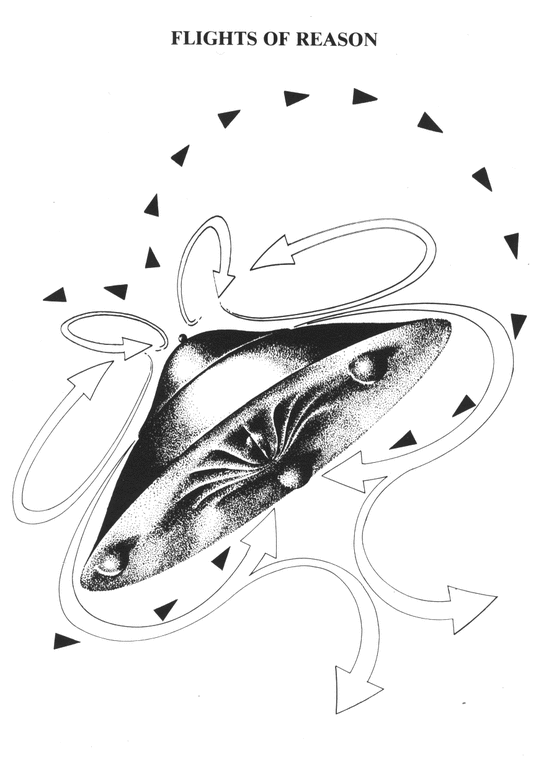 One of the hottest debates in physics today is over the true nature of space: Is it a 'luminiferous aether' (see Wikipedia) or is it some abstract, ten-dimensional, Reimannian construction like Dr. Albert Einstein proposed in his Theory of General Relativity? If it does, indeed, require a superdimensioned construction to explain the physical laws of the universe, one must wonder why this construction could not be replaced by one using real and observable dimensions like width, length, and depth... If, on the other hand, space is a 'luminiferous ether' or some tenuous 'fluid', then one wonders why the functions of the physical laws of the universe cannot be observed; and, hence, translated into a mathematical construct of reality... of three real dimensions with time expressed as a ratio of relative distances and vectors. Strange as it may seem, space has already been properly described right here on Earth as far back as 1954! Space is a 'fine structure'... a 'tenuous medium, fluid or field'. All gravitational, electromagnetic, and electrostatic phenomena occur as results of various interactions of energy 'waves' in this 'fluid space'. In pages 172-174, 176, 178 and 180 of Scientific American in 1954, a brilliant discussion giving three-dimensional explanations of many nuclear phenomena (based largely on previous discussions written by Douglass Crockwell) was conducted by Albert G. Ingalls. Crockwell's explanations offer the only real solution to the apparent paradox which certain nuclear events present to the researcher: A particle sometimes behaves like a wave. The discussion stated: "It seems reasonable, as a first thought to accept each particle-field relationship as an inseparable something, which is perceived sometimes in one fashion and sometimes in another. We might also think of the particle portion of the effect as that which is experienced radial to the course or potential course. We know that some relationship of this sort exists, whether or not it is exactly as stated. Variation of one effect is accompanied by a reciprocal variation in the other effect. In other words, the more the particle field manifests itself as a particle, the less it manifests itself as a field, and vice versa." "... We also know that charged particles in motion exhibit a 'sense' or quality of right - or left-handedness which characterizes their charges... From this we can infer a kind of tangential motion in space around the course of a particle - a motion which differs between particles of unlike charge." The discussion went on to say, "...It is important to remember that the field does not rotate as a unit. The areas of the field vary only in the diameter and the phase of translation. As the field is explored from the centre outward, the phase of rotation lags progressively. Hence, its structure can be considered as a series of concentric phase shells, each 360 degrees out of step with adjoining neighbours." "The field and particle are one, and at all points the action is similar. The diameter of translation is greatest when the particle is at relative rest. An increase of particle-field velocity is accompanied by an increased rate of rotation but a smaller radius of rotation." The summary statements of the discussion brought out a very interesting point about James Clerk Maxwell - the Einstein of the nineteenth century: "I submit a line from the great James Clerk Maxwell's preface to his theory of electromagnetic radiation: 'In several parts of this treatise, an attempt has been made to explain electromagnetic phenomena by means of a mechanical action...' " A very common phenomenon illustrates Crockwell's model 'particle-field' concept. If one blows a weak 'smoke ring', it moves slowly away in a rapidly-widening ring. If, however, one blows a strong 'smoke ring', it moves away rapidly - maintaining a very small diameter. If a person nearby were struck by the latter smoke ring, the impulse or particle effect would be more obvious than the tangential expansion pressure on the ring. On the other hand, if that some person were struck by the first smoke ring of less translational energy, it would not be felt as a direct impact so much as an expanding crawl over the individual's person. Although it would prove a bit difficult in practice, one could, theoretically, shoot two smoke rings at each other so that their encounter would produce either mutual annihilation or mutual enhancement dependent upon the rotation vector applied to each ring as it left the issuing orifice. The annihilation would produce a visual effect like a 'barred-spiral galaxy' while the enhancement would produce a visual effect like the 'Sombrero galaxy'. The reader who is keenly interested in the mechanics of gravity and electromagnetism must pursue the preceding lines of thought to properly understand the 'missing link' which unites the physical laws of the microcosm with those of the macrocosm. If one views 'space' as an infinite existence - a continuum - comprised of endless levels of subnuclear particle-fields forming atoms forming planetary systems which form galaxies that, in turn, form galactic cells and, etc. ad infinitum, then one can easily visualize that the 'ether' of man's particular level of existence is a 'fluid' comprised of ultra-small 'particle-fields' which, in turn, are made-up of relatively equally small 'particle-fields'. 'Time', as such, in a continuum of such magnitude is equally relative. 'Time' is not an absolute dimension in reality. The only absolute is energy. The distribution of energy within the various levels of the hierarchy of existence creates the phenomenon called, 'time'. As the distribution of energy is not uniform, 'time' itself, is not uniform in the universe. When a person says it took him five seconds to walk across a room, he is really saying a clock pendulum moved or changed its energy-distribution level five times as compared to his own, single change of energy-distribution made by his walk across the room. Time is a ratio of changes in energy-density. 'Time' on an atom passes much faster than 'time' at the Earth level does. If a person's body were to be 'pumped' with resonant energy, it would make him age several days in only a few relative minutes to someone watching him. If, however, the person were to be 'drained' with resonant energy, it would lower his energy-density causing him to age only a few minutes in several relative days of the observer's time. How incredible it would be... Suppose a group of scientists had to solve a very time-dependent problem in a hurry. If they were to take their pencils and paper with themselves into a 'field' which harmonically 'pumped' their energy-densities to a higher level, 'time' would extend for them. They would have several relative days to solve their problem while only a few relative minutes of time had passed to the world outside their 'field'... fascinating... isn't it?! If the American base at Pine Gap could be used to 'pump' resonant, low frequency energy into certain circles of the country, the effects could be mind-boggling. Why, in just a few days of time relative to the rest of the world, certain parts of Australia could pass several years of time relative to its occupants. Has the reader ever had those days that seem to 'fly by'?... On the other hand, if the same facility could be used to 'drain' energy from those same circles of influence, the days would seem to'drag by' to those so influenced... If an electric air- or space-craft based on the same principle of resonance were to be suddenly accelerated into a new vector at speeds which would normally break its molecular lattice apart, a 'relative' or 'apparent' 35g acceleration could be easily amortized over a relative 'time-dilation' of 1:35 inside the field of the craft... giving the craft and its crew the relative acceleration of only 1g...! If the reader has been able to grasp the preceding dissertation on time and space, he now knows why 'UFOs' have such incredible performance characteristics. They are only relatively incredible... THE 'GRAVITATIONAL' EFFECT The reader is asked to examine figures (3-a), (3-b), and (3-c). All three figures represent the same 'system' in different energy states. The system consists of a rectangular fish-tank - sealed on all sides. The pump (c) pumps water into the tank through hole (a) and extracts the water from hole (b). A small trolley car (d) with one, upright end resides on the track (f). Assuming that no air bubbles appear in the circulation patterns, when the pump is activated, the trolley car will move away from the water inlet (a) toward the end (e) with no visible means of acceleration to an observer outside the tank. The trolley car will come to rest flat against the end as shown in figure (3-b). Now, let the same process be repeated with several holes having been drilled through the trolley car's upright as shown in figure (3-c). The trolley car will not come to rest flat against the end (e). Instead, it will stand back from the end a certain distance. To the observer, the trolley car would have oscillated toward the end (e) very briefly before coming to rest in the position shown. The reason is plain: The water from the inlet struck the upright driving it toward (e); however, some of the water passed through the holes in the upright striking (e) and rebounding back into the upright as it approached (e) creating an 'energy-cushion' between the end and the upright. So, as long as the observer could not see or feel the energy 'waves' moving the trolley car he could only deduce some 'force' was at work which had either 'pushed' or 'pulled' the trolley car to the end. If the observer could then somehow place his hand into the tank while the system was operating, without destroying the pressure seal, he could take the upright in his fingers and move it toward the end (e). Upon releasing the trolley car, he would see it move away from the end (e) returning to its former position - however, this time the observer would have 'felt' the force that tugged at the trolley car. Yet, that 'force' was actually the resultant of one force acting upon its own partial reflection from the end (e). If the observer could then move the trolley car toward the end of the water inlet (a), he would find that the 'tugging' force had apparently reversed direction as it would then be pulling toward the end (e). He would then realize that releasing the trolley car would allow it to 'gravitate' to the point along the track (f) where the force of the incoming water was being balanced by the force of the reflected water. In reality, all mass on the surface or outer shell of the Earth is matter whose nuclear density (like the holes in the upright) has caused it to 'gravitate' to that distance or radius which is the resultant of an energy-input-vase passing through its nuclear holes, meeting itself in the center of Earth, and reflecting back toward itself. The center of the Earth is like the end (e) while that spot where the trolley cat 'gravitates - to' is like the surface of Earth. Certain conclusions follow from these observations. Firstly, 'gravity' is the resultant of a bidirectional pair of forces. Secondly, 'gravity' has higher oscillation frequencies the closer the observer approaches to the center of the input-energy wave reflection point. Thirdly, a mass whose nuclear 'hole-spacing' gives it a greater 'particle-field' density than another with more 'holes' per unit area will not reside at the same radius from the 'center' as the other will. It will, in fact, reside closer to the center. This effect can be detected on the Earth's surface, by a study of the, so-called, 'specific gravitational nature' of the elements - which will show that 'gravity' and 'specific gravity' are the same phenomenon. It is quite simple. Even though acceleration due to gravity is basically a constant on Earth, when a mass takes on a 'gravitational' radius from the center of the Earth it is related to the ratio of its atomic 'particle-field' areas divided into the atomic spacing areas (or 'holes'). Therefore, those masses of the higher ratios of 'particle-field' densities to atomic 'holes' reside closer to the centre; and are referred to as more dense objects. That mass whose ratio approaches infinity converts to pure, radiant energy from the center of the system. The 'gravitational' effect is, in reality, the resultant of more than just two opposing forces. As any object must have spin around its own axis to have the effect, it follows that the 'gravitational' effect is the resultant of the spin/anti-spin moments and the convergent/divergent moments... This is the reason that 'gravitational' fields vary by the fourth power of their angular velocity in free space. Such a theory of 'gravity' also predicts that 'gravitational' shells exist in any 'gravitational' field. These shells would give the illusion that 'gravity' reversed its direction as one approached the center of the generating field. In this theory, if one were to drill a hole to the center of the Earth, and were to drop a stone down that hole, one could expect the stone to fall only a portion of the distance to the center before reversing direction and 'falling' back up the hole until it found its shell of balanced forces. Recent tests have even visually shown the Sun has at least one such inner shell which can be 'seen' through the sunspots. This inner shell spins so fast, that for the first time it appears that the hyperbolic equation which Laplace once formulated for orbital radius versus relative velocity is totally acceptable! THE 'MAGNETIC' EFFECT
'Magnetism' is the same type of phenomenon as 'gravity'. All things in normal states can be 'magnetised' to some degree. 'Gravity', also, normally affects all things in its field. 'Gravity' has frequency and so does 'magnetism'. 'Gravity' has 'shells' of balanced forces and so does 'magnetism'. Where is the difference? It is quite simple. If a mass (like the Earth) spins around its own axis, the resulting reductions of pressure in the 'fluid of space' (see Appendix 5) produce 'gravity'. As the sub-particles of this mass (like electrons) orbit a chain of atoms in spiralling courses - thus reducing the pressure at right angles to the particle path in the 'fluid of space' - an interlocking series of vectors give the illusion of 'magnetism'. The motion of Earth around the Sun could be called a 'magnetic' moment while its motion around its own axis is a 'gravitic' moment. The frequency of a nuclear magnetic field is very high when compared to the frequency of the gravitic field that contains the Earth. 'Gravity' is a source of power and so is 'magnetism'. Both are results of balanced-but dynamic forces. By introducing shielding or a method of diverting the energy density of one 'shell' to a lower state 'shell' one can draw energy from both fields. There is more - much more to say - but it might prove too technical for this book. In a forthcoming publication, the author will thoroughly explain 'gravity' and 'magnetism' as functions of inertial waves in the 'ether' or 'the fine structure' of 'space'. The mystery of the so called 'North' and 'South' poles of magnets will be visually explained as will be the 'right-hand' twist of magnetic fields. A method of utilizing 'gravity' as a means of transport will also be detailed by a discussion of the use of resonating, low-frequency, high-voltage electric fields. But, these things must wait for the present moment. SOME SECRET SCIENCES In 1971 Dr. Oleg Jefimenko - a scientist at West Virginia University announced the world's first practical motor to be powered by the Earth's electric field. He claimed his motor could be used to avert the power shortage in the Western world. He was correct; however, the details of his process were quickly silenced. It is known that his process used an electrostatic motor to generate motion - and, hence, power. His first generator apparently used a balloon-lofted wire to 'short-out' the differential voltages between earth's surface and 1500ft above the surface. His unit produced about one-tenth of a horsepower of continuous energy with only the earth's electric field as a power source. The only solid leaks this author could find which illustrated Dr. Jefimenko's technique were printed in the Scientific American magazine. Unfortunately, the magazine would not give this author permission to reprint the articles or the drawings of Dr. Jefimenko's generator; so the reader must follow-up these leads himself: Scientific American, October 1974, p.126-131; and March 1972, p.57... (Do it). The reader should also secure a copy of the following document from either the Wright Air Development Centre at Wright-Patterson Air Force Base in Ohio or the University of North Carolina Physics Department at Chapel Hill, North Carolina: Conference on the Role of Gravitation in Physics, WADC Technical Report 57-216 (March 1957) or ASTIA document No. AD118180. This report gives 167 pages of summary on the proceedings of a conference attended by the world's 44 leading physicists who came from London, Copenhagen, France, Turkey, Stockholm, Japan, Switzerland, and America. In 1972, a Yugoslav-born physicist, Mr. Bogdan Maglich, announced a new power source for the home. Mr. Maghch made his announcement while on leave from Rutgers University where he was a professor. His new power source was detailed in a paper to the American Physical Society. The power source was about the size of a domestic air-conditioning unit. It used colliding beams of deuterons (the nuclei of heavy hydrogen) enclosed in a magnetic field as the power source. It could 'breed' its own fuel while it generated electricity - directly - with no steam turbines or any other sort of the usual intermediary devices... What ever became of Mr. Maglich's process? A wealth of information on classified research projects is available to the reader for a fee of around $100 from the Smithsonian Science Information Exchange located in Washington D.C. (20036) at Room 300 of 1730 M Street, N.W. All the reader need do, is join the organization (for a very small fee) and then ask for a "Notice of Research Report" on whatever subject he wishes. This author asked for, Electro-Gravitic Propulsion Systems For Aircraft and Spacecraft since 1975. A book of thirty project summaries was sent in response. Some of the highlights follow: a) Pulsed Electromagnetic Gas Acceleration - supported by an unspecified unit within N.A.S.A. at Washington D.C.; annual funds in excess of $160,000; research being performed by the School of Engineering and Applied Sciences at Princeton University, Box 430, Princeton, New Jersey 08540;... The research is studying plasma propulsion devices for space flight as well as for plasma dynamic lasers. b) Properties and Behaviour of Explosion Fields and Plasma Flows - supported by the U.S. Dept. of Defence for the Air Force under contract number DF024930 and F44620-75-C-0021; funding of $30,730 for fiscal year 1977; development by Air Vehicle Corporation of San Diego, Calif.; ...the research is developing an advanced plasmadynamic electric propulsion engine with very high rate energy conversion devices. These techniques are to be used for satellite surveillance and close air support. c) Magnetic Field Annihilation of Impulsive Plasma Current Sheets - supported by the U.S. Dept. of Defence for the Air Force under contract number DF029200 and F44620-71-C-0031; development by Thomson Baron Woolridge Inc. of 1 Space Park at Redondo Beach, Calif. 90278; funding of $60,508 for fiscal year 1976;...the project is pursuing the conversion of magnetic energy to plasma kinetic energy through the annihilation of anti-parallel magnetic fields. Furthermore, it is pursuing the development of large, total-impulse, acceleration devices using pulsed plasma thrusters for orbit acquisition and stationkeeping. d) Mechanisms of Magnetoplasmadynamic Arc Jet Acceleration Processes - supported by U.S. Dept. of Defence for the Air Force under contract number DF037860 and F44620-74-C-0017; annual funds of $15,475 in fiscal year 1977; development by Techion Inc. of Newport Beach, Calif; ....with the main purpose of using the atmospheric environment as an arc jet propellant source for a magneto-plasma-dynamic, arc-operated space thruster,... which would be code-named SERJ (for space electric ramjet). e) Experimental Research on Fluid Dynamic Energy Conversion and Transfer Processes - supported by the U.S. Dept. of Defence for the Air Force under contract number DF136500 and F33615-73-C-4053; with fiscal year funds of $313,098 in 1977; development by Universal Energy Systems, Inc. of Medway, Ohio, 45341 under the eye of the supporting agency's Flight Dynamics Laboratory at Wright-Patterson AFB also in Ohio; ...purpose: to design new aerospace propulsion systems and electromagnetic weapons. f) New Horizons in Propulsion - supported by N.A.S.A.'s Office of Space Science Jet Propulsion Lab at the California Institute of Technology in Pasadena, Calif. 91109; funds undisclosed; this project was designed to explore several new areas of propulsion: 1) the production and storage of antimatter along with the use of matter/antimatter mutual annihilations as a propulsive source. 2) the study of new methods of obtaining energy from the interaction between an electrically-conducting fluid in turbulent motion aboard a spacecraft and the fluctuating magnetic field of a nearby planet, 3) the utilization of various planelary atmospheres as propulsion systems, 4) the design of a practical process for converting high energy-density sources into thrust, and 5) the use of lasers as propulsion systems. There is more... much more. Why is it that the U.S. Government stated that they had no 'death-ray' during the 1977 controversy? One must wonder since it is common knowledge in Australia that as early as 1973 the U.S. had destroyed an Australian drone aircraft over five miles away with a ship-board plasma cannon ("Sky-Cannon") which could only be photographed with special cameras operating at over fifty thousand frames a second! Consider the statement of Dr. Stanton T. Friedman - a well-known nuclear physicist - who said that he had personally assisted on various developmental stages of ion-thruster engines for "small companies" like Westinghouse, General Electric, and General Motors. In fact, he stated that Westinghouse had already test-fired an 1100 megawatt ion-thrust engine sometime before 1970. The proof is everywhere... everywhere...; but, why hasn't the reader been told? This question must be answered - disclosure should not be mission impossible!
1 Comment
5/7/2012 12:17:20 am
I haven’t any word to appreciate this post.... I think this is really a great thing about the fashion. Really I am impressed from this post. I am very happy to read this article. Thanks for giving us nice info. Fantastic walk-through. I appreciate this post.
Reply
Your comment will be posted after it is approved.
Leave a Reply. |
News Watch
Mind-opening news articles, editorials, videos & apparel that inspire our readers and help liberate them from the status quo. Stay informed.
Write For UsSpace WatchTop NewsNews Watch Categories
All
|
|
|
HAVE A TIP OR STORY TO TELL? JOIN TODAY & SHARE YOUR STORY!
If you have a breaking news tip or idea, please email: [email protected] Apparently Apparel® is a registered trade name and part of the ZOAT International® brands network. © 2007-2023. All Rights Reserved. Privacy Policy. All art & news content posted on this site is commentary or opinion and is protected under Free Speech. ApparentlyApparel.com is not responsible for content written by contributing artists, authors or news feeds. The information on this site is provided for educational and entertainment purposes only. It is not intended as a substitute for professional advice of any kind. ApparentlyApparel.com assumes no responsibility for the use or misuse of this material.
|
|









